1997 CHEVROLET BLAZER brakes
[x] Cancel search: brakesPage 188 of 402
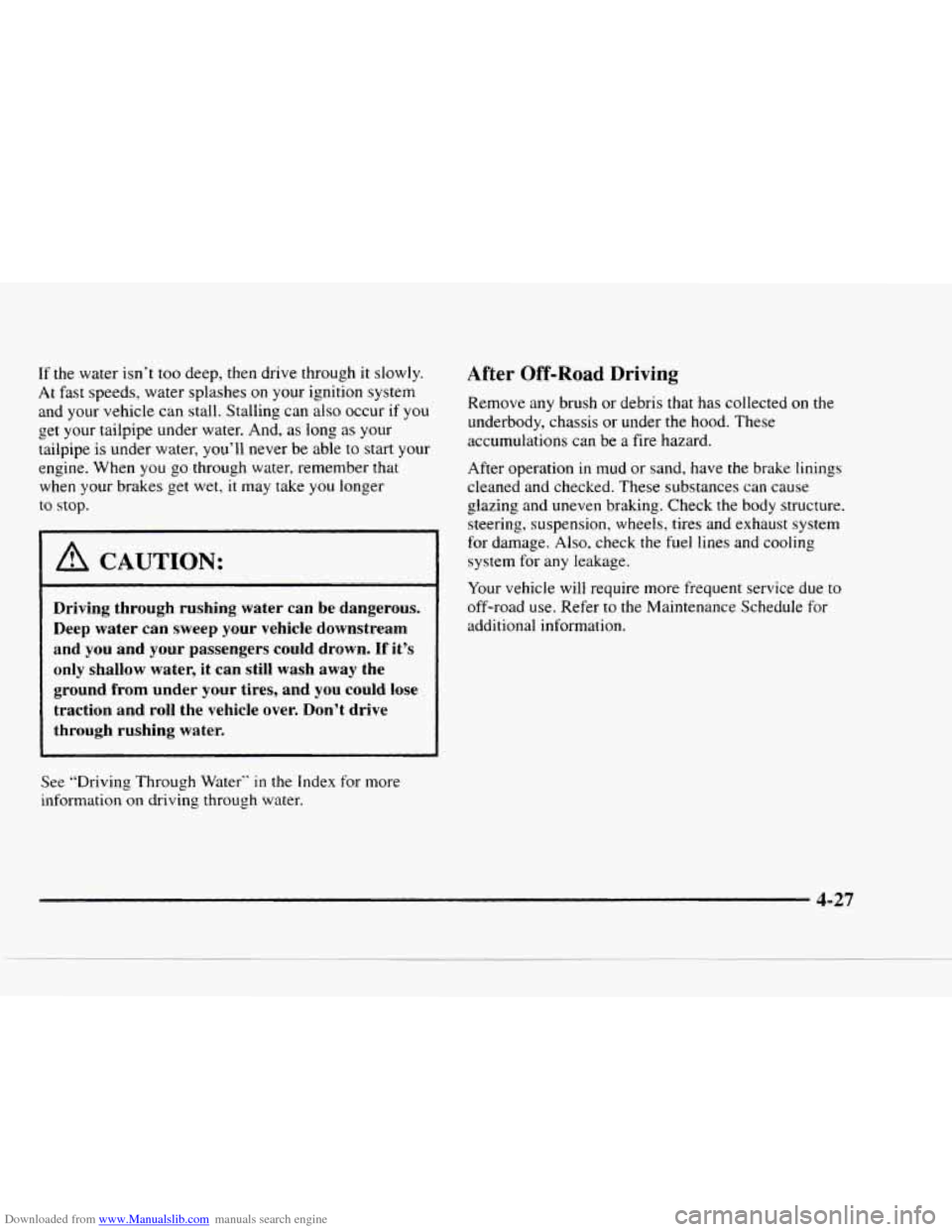
Downloaded from www.Manualslib.com manuals search engine If the water isn’t too deep, then drive through it slowly.
At fast speeds, water splashes
on your ignition system
and your vehicle can stall. Stalling can also occur if you
b get your tailpipe under water. And, as long as your
tailpipe is under water, you’ll never be able
to start your
engine. When
you go through water, remember that
when your brakes get wet, it may take you longer
to stop.
I A CAUTION:
Driving through rushing water can be dangerous.
Deep water can sweep your vehicle downstream
and you and your passengers could drown.
If it’s
only shallow water, it can still wash away the
ground from under your tires, and you could lose
traction and roll the vehicle over. Don’t drive
through rushing water.
See “Driving Through Water” in the Index for more
information on driving throwh water.
After Off-Road Driving
Remove any brush or debris that has collected on the
underbody, chassis or under the hood. These
accumulations can be
a fire hazard.
After operation in mud or sand, have
the brake linings
cleaned and checked. These substances can cause
glazing and uneven braking. Check the body structure.
steering, suspension, wheels, tires and exhaust system
for damage. Also, check the fuel lines and cooling
system for any leakage.
Your vehicle will require more frequent service due
to
off-road use. Refer to the Maintenance Schedule for
additional information.
Page 191 of 402

Downloaded from www.Manualslib.com manuals search engine The heavier the rain, the harder it is to see. Even if your
windshield wiper blades are
in good shape, a heavy rain
can make
it harder to see road signs and traffic sipals.
pavement markings. the edge
of the road and even
people walking.
It's wise to keep
your wiping equipment in good shape
and keep your windshield washer tank filled
with
washer fluid. Replace your windshield wiper inserts
when they show signs
of streaking or missing areas on
the windshield, or when strips of rubber start to separate
from the inserts. Driving
too
fast through large water puddles or even
going through
some car washes can cause problems, too.
The water may affect your brakes. Try to avoid puddles.
But if you can't. try to slow down before you hit them.
I A CAUTION:
Wet brakes can cause accidents. They won't work
as
well in a quick stop and may cause pulling to
one side. You could lose control
of the vehicle.
After driving through
a large puddle of water or
a car wash, apply your brake pedal lightly until
your brakes work normally.
4-30
Page 197 of 402
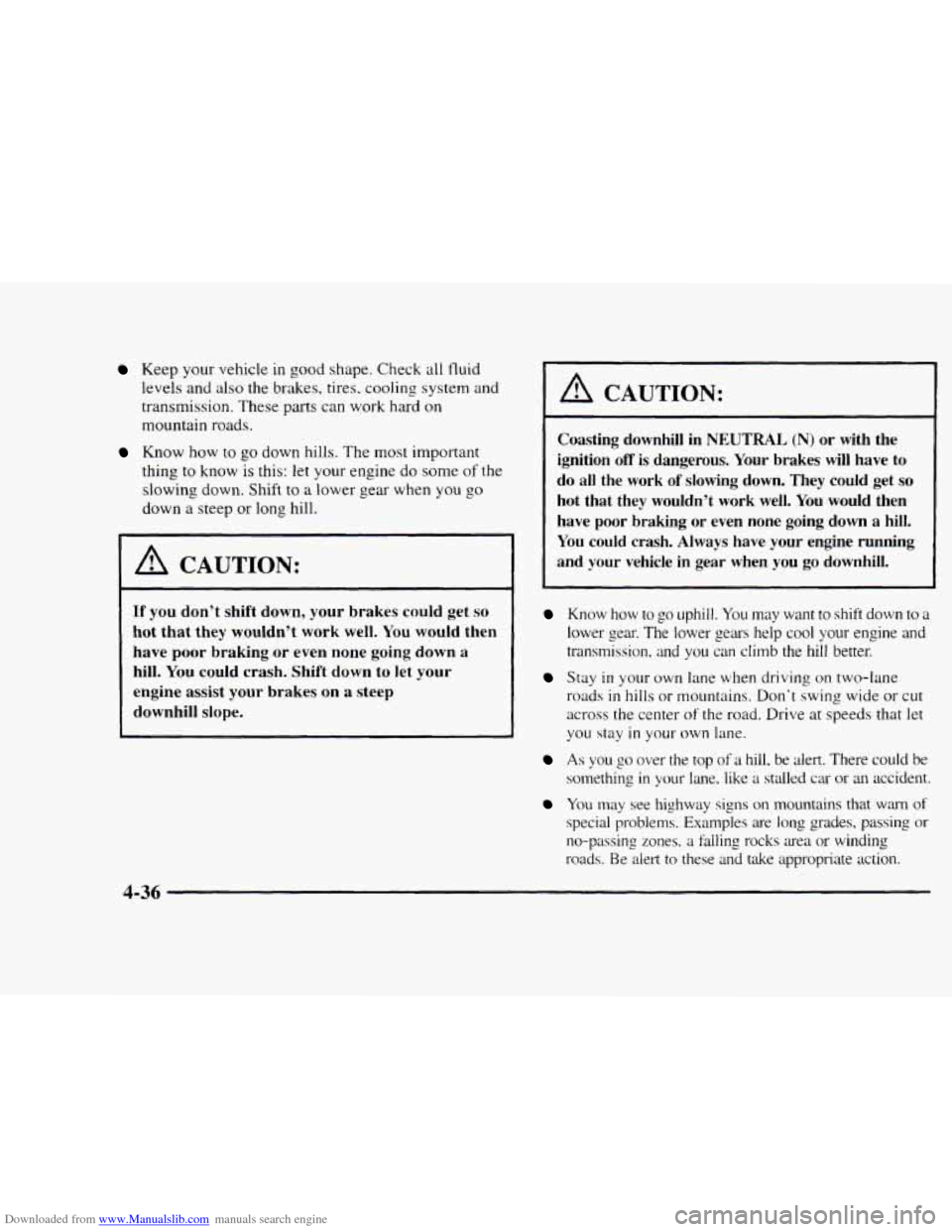
Downloaded from www.Manualslib.com manuals search engine Keep your vehicle in good shape. Check all fluid
levels and
also the brakes, tires. cooling system and
transmission. These parts can work hard
on
mountain roads.
Know how to go down hills. The most important
thing
to know is this: let your engine do some of the
slowing down. Shift
to a lower gear when you go
down a steep or long hill.
A CAUTION:
If you don’t shift down, your brakes could get so
hot that they wouldn’t work well. You would then
have poor braking or even none going down a
hill.
You could crash. Shift down to let your
engine assist your brakes on a steep
downhill slope.
I A CAUTION:
Coasting downhill in NEUTRAL (N) or with the
ignition
off is dangerous. Your brakes will have to
do all the work
of slowing down. They could get so
hot that they wouldn’t work well. You would then
have poor braking or even none going down a hill.
You could crash. Always have your engine running
and your vehicle in gear when you go downhill.
Know how to go uphill. You may want to shift down to a
lower gear. The lower gears help cool your engine and
transmission. and you can climb the
hill better.
Stay in your own lane when driving on two-lane
roads
in hills or mountains. Don‘t swing wide or cut
across the center
of the road. Drive at speeds that let
you stay in your own lane.
As you go over the top of a hill, be alert. There could be
something
in your lane. like a. stalled car or an accident.
You may see hishway signs on mountains that warn of
special problems. Examples are long grades, passing or
no-passing zones.
a falling rocks area or winding
roads.
Be alert to these and take appropriate action.
4-36
Page 199 of 402

Downloaded from www.Manualslib.com manuals search engine A
‘‘1 :- ................ .................. . .. .. ....,.___.__..___._._.._... .. . . . . . . . . . . . . . . . . . . . , . , . . . , . . . . . , . , , , ,.I
What’s the worst time for this’? “Wet ice.“ Very cold
snow or ice can be slick and hard
to drive on. But wet
ice can be even more trouble because
it may offer the
least traction
of all. You can get wet ice when it’s about
freezing
(32°F; OOC) and freezing rain begins to fall.
Try to avoid driving on wet ice until salt and sand crews
can get there. Whatever
the condition
-- smooth ice, packed, blowing
or loose snow
-- drive with caution.
Accelerate gently. Try
not to break the fragile traction. If
you accelerate too fast. the drive wheels will spin and
polish the surface under the tires even more.
Your anti-lock brakes improve your vehicle’s stability
when you make a hard stop
on a slippery road. Even
though
you have an anti-lock braking system, you’ll
want
to begin stopping sooner than you would on dry
pavement. See “Anti-Lock” in
the Index.
Allow greater following distance on any
slippery road.
Watch for slippery spots. The road might be fine
until you hit a spot that’s covered with ice. On an
otherwise clear road, ice patches may appear in
shaded areas where the sun can’t reach: around
clumps
of trees, behind buildings or under bridges.
Sometimes the surface of a curve or an overpass may
remain icy
when the surrounding roads are clear. If
you see a patch of ice ahead of you, brake before you
are on it. Try not to brake while you’re actually on
the ice, and avoid sudden steering maneuvers.
4-38
Page 206 of 402
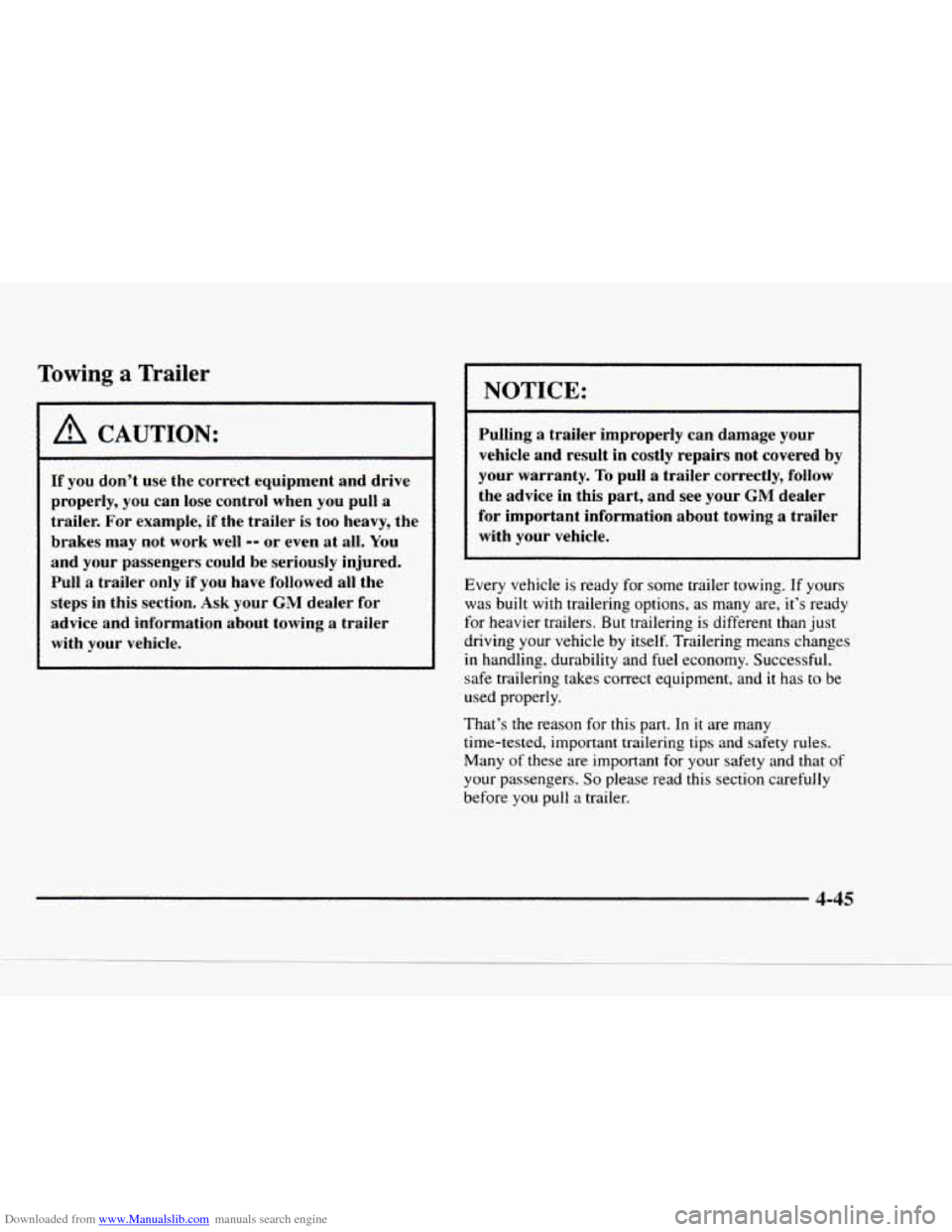
Downloaded from www.Manualslib.com manuals search engine Towing a Trailer
I A CAUTION:
If you don’t use the correct equipment and drive
properly, you can lose control when you pull
a
trailer. For example, if the trailer is too heavy, the
brakes may not work well
-- or even at all. You
and your passengers could be seriously injured.
Pull a trailer only if you have followed all the
steps in this section.
Ask your GM dealer for
advice and information about towing a trailer
with your vehicle.
I NOTICE:
I
~ Pulling a trailer improperly can damage your
i vehicle and result in costly repairs not covered by
your warranty.
To pull a trailer correctly, follow
the advice in this part, and see your
GM dealer
for important information about towing
a trailer
I
~ with your vehicle.
Every vehicle is ready for $time trailer towing. If yours
was built with trailering options, as many are, it’s ready
for heavier trailers. But trailering is different than just
driving your vehicle
by itself. Trailering means changes
in handling, durability and fuel economy. Successful.
safe trailering takes correct equipment, and
it has to be
used properly.
That’s
the reason for this part. In it are many
time-tested, important trailering tips and safety rules.
Many of these are important for your safety and that
of
your passengers. So please read this section carefully
before
you pull a trailer.
4-45
Page 210 of 402
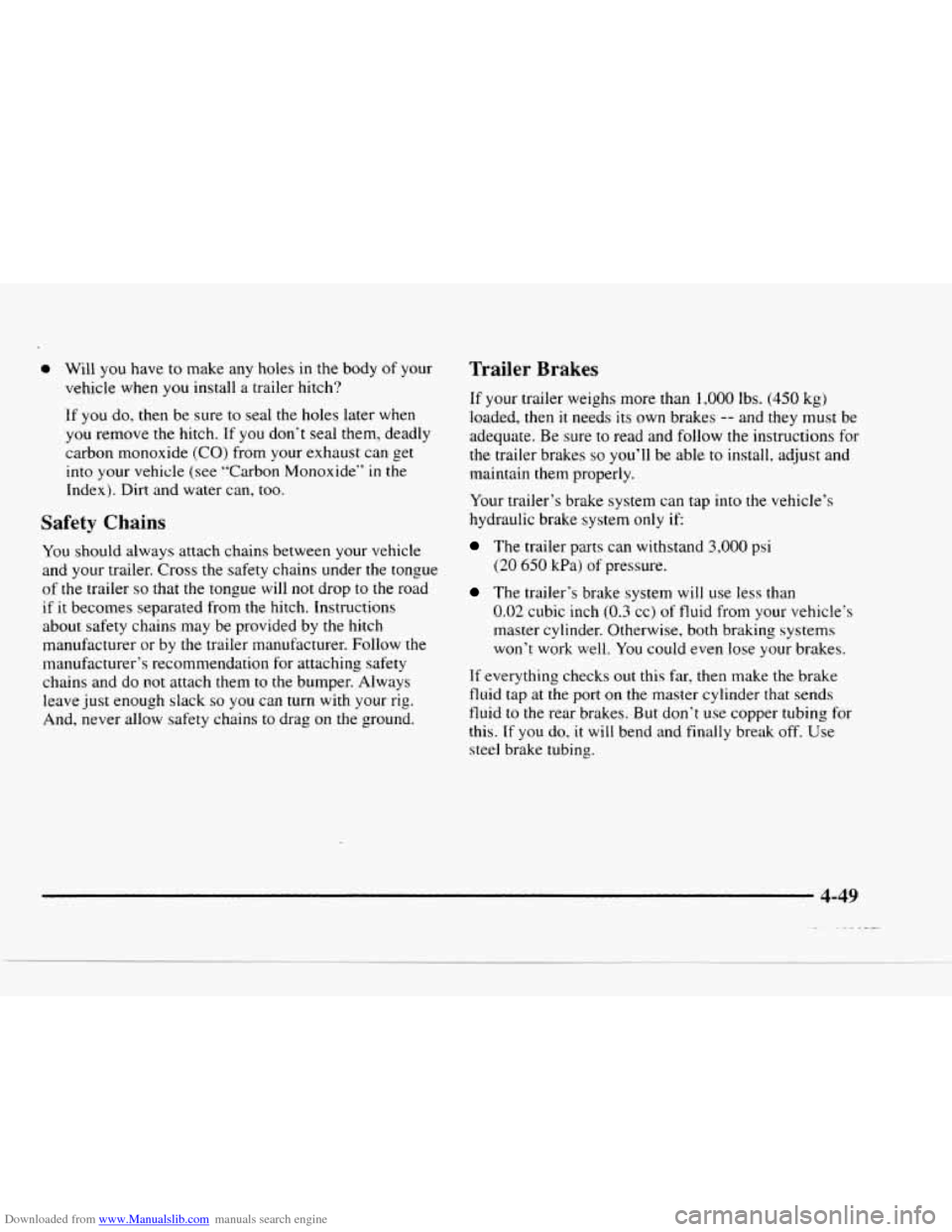
Downloaded from www.Manualslib.com manuals search engine 0 Will you have to make any holes in the body of your
vehicle when you install a trailer hitch?
If you do, then be sure to seal the holes later when
you remove the hitch. If you don’t seal them, deadly
carbon monoxide
(CO) from your exhaust can get
into your
vehicle (see “Carbon Monoxide” in the
Index). Dirt and water can, too.
Safety Chains
You should always attach chains between your vehicle
and your trailer. Cross the safety chains under the tongue
of the trailer so that the tongue will not drop to the road
if it becomes separated from the hitch. instructions
about safety chains may be provided by the hitch
manufacturer or by
the trailer manufacturer. Follow the
manufacturer’s recommendation for attaching safety
chains and do not attach them to the bumper. Always
leave
just enough slack so you can turn with your rig.
And, never allow safety chains
to drag on the ground.
Trailer Brakes
If your trailer weighs more than 1,000 Ibs. (450 kg)
loaded, then it needs its own brakes -- and they must be
adequate. Be sure to read and follow the instructions
for
the trailer brakes so you’ll be able to install, adjust and
maintain them properly.
Your trailer’s brake system can tap
into the vehicle’s
hydraulic brake system
only if
The trailer parts can withstand 3,000 psi
(20 650 kPa) of pressure.
The trailer’s brake system will use less than
0.02 cubic inch (0.3 cc) of fluid from your vehicle’s
master cylinder. Otherwise, both braking systems
won’t work well. You could even lose your brakes.
If everything checks out this far, then make the brake
fluid tap at the port
on the master cylinder that sends
fluid to
the rear brakes. But don’t use copper tubing for
this.
if you do, it will bend and finally break off. Use
steel brake tubing.
Page 211 of 402
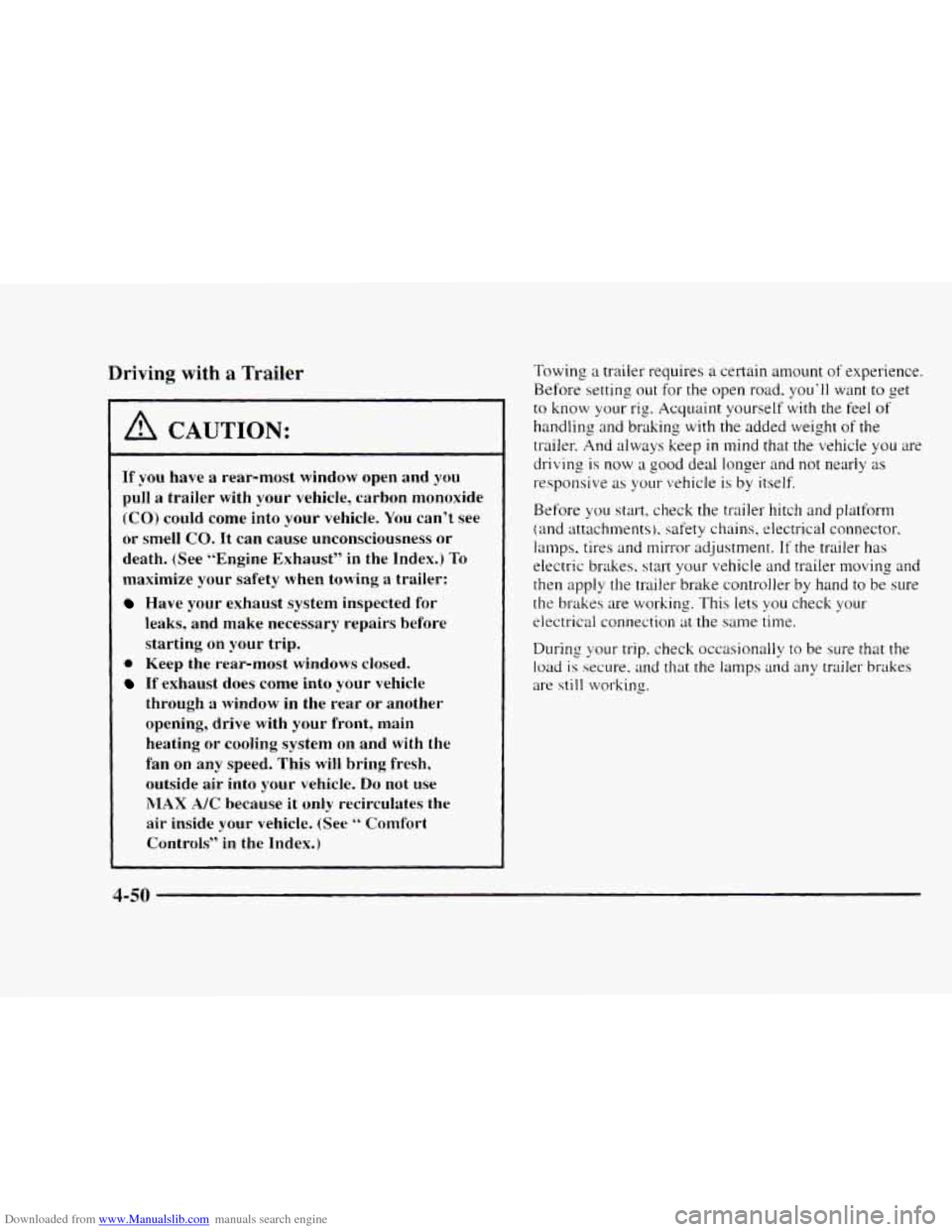
Downloaded from www.Manualslib.com manuals search engine Driving with a Trailer
If you have a rear-most window open and you
pull a trailer with your vehicle, carbon monoxide
(CO) could come into your vehicle. You can’t see
or smell
CO. It can cause unconsciousness or
death. (See “Engine Exhaust” in the Index.)
To
maximize your safety when towing a trailer:
Have your exhaust system inspected for
leaks, and make necessary repairs before
starting on your trip.
0 Keep the rear-most windows closed.
If exhaust does come into your vehicle
through
a window in the rear or another
opening, drive with your front, main heating or cooling system on and
with the
fan on
any speed. This will bring fresh,
outside
air into your vehicle. Do not use
MAX A/C because it only recirculates the
air inside your vehicle. (See b‘ Comfort
Controls”
in the Index.) Towing
a trailer requires a certain
amount of experience.
Before setting out for the open road. you‘ll want
to get
to know your rig. Acquaint yourself with the feel of
handling and braking with the added weight of the
trailer. And always keep in mind that the vehicle you are
driving
is now a good deal longer and not nearly as
responsive as your vehicle is by itself.
Before
you start, check the trailer hitch and platform
(and attachments). safety chains. electrical connector,
lamps, tires and mirror adjustment. If the trailer has
electric brakes. start your vehicle and trailer moving and
then apply the trailer brake controller by hand to be sure
the brakes are working. This lets
you check your
electrical connection at the same time.
During your trip. check occasionally to be sure that the
load is secure. and that the lamps and any trailer brakes
are still working.
4-50
Page 213 of 402

Downloaded from www.Manualslib.com manuals search engine When towing a trailer, the arrows on your instrument
panel
will flash for turns even if the bulbs on the trailer
are burned out. Thus, you may
think drivers behind you
are seeing your signal when they are not. It's important
to check occasionally to be sure the trailer bulbs are
still working.
Driving On Grades
Reduce speed and shift to a lower gear byfilw you start
down
a long or steep downgrade. If you don't shift
down. you might have to use your brakes
so much that
they would get hot and no longer work well.
On
a long uphill grade. shift down and reduce your
speed
to around 45 mph (70 km/h) to reduce the
possibility of engine and transmission overheating.
if
you have an automatic transmission. you should use
DRIVE (D) when towing a trailer. Operating your
vehicle in DRIVE (D) when towing a trailer will
minimize heat buildup and extend the life
of your
transmission. Or.
if you have a manual transmission. it's
better not to use
FIFTH (5 j gear. just drive in
FOURTH (4) gear (or. as you need to. a lower gear). When
towing
at high altitude on steep uphill grades.
consider the following: Engine coolant will boil at a
lower temperature than at normal altitudes.
If you turn
your engine off immediately after towing at high altitude
on steep uphill grades, your vehicle may show signs
similar to engine overheating.
To avoid this. let the
engine
run while parked (preferably on level ground)
with the automatic transmission in PARK (P) (or the
rnanual transmission out of gear and the parking brake
applied) for a few minutes before turning the engine off.
If you do get the overheat warning, see "Engine
Overheating"
in the Index.
Parking on Hills
You really should not park your vehicle. with a trailer
attached.
on ;I hill. If something goes wrong, your ris
could start to move. People can be injured, and both
your vehicle and the trailer
can be damaged.
4-52